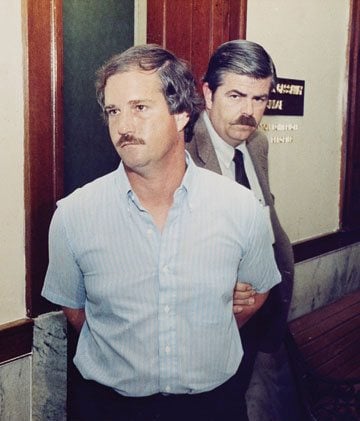The Arson Files: Judge Recommends New Trial for Ed Graf


A state district judge in Waco on Thursday recommended a new trial for Ed Graf, who has spent nearly 25 years in prison on an arson conviction that forensic experts now say was based on junk science.
Retired Judge George Allen recommended throwing out Graf’s conviction and convening a new trial after a brief hearing this morning to review the well-documented flaws in the forensic evidence. The case now goes before the Texas Court of Criminal Appeals.
Graf was convicted in 1988 of allegedly starting the fire that killed his 8- and 9-year-old stepsons in the shed behind the family’s home in a Waco suburb. Graf always claimed he was innocent, and the physical evidence seems to confirm that he’s served a quarter century in prison for an arson that never happened.
Thursday’s hearing, held in a first-floor courtroom in the McLennan County courthouse annex, lasted barely five minutes. Graf’s lawyer Walter Reaves and Assistant District Attorney Alex Bell agreed that the physical evidence used to convict Graf in 1988 was flawed. “Were the case tried today, there is no scientific evidence…of arson,” said Reaves, an innocence attorney who’s been working to exonerate Graf for more than five years. (Graf was one of three flawed arson cases the Observer investigated in 2009. Read our original 2009 story on Graf’s conviction here. You can read other stories in our four-part series on debunked arson evidence here.)
Bell wouldn’t concede Graf’s innocence. The prosecutor pointed to the circumstantial evidence that made Graf appear guilty: He took out life insurance policies on the boys just two months before their deaths; he insisted the boys keep the tags on their new clothes and then returned them for a refund after the fire; he hadn’t bought them more cereal like he usually did. (The circumstantial evidence is the reason that Clare Bradburn, Graf’s ex-wife and the mother of the boys, remains convinced of his guilt, as she told the Waco Herald-Tribune last week.) But Bell agreed the forensic evidence in the case was problematic and that justice demanded a new trial. “We agree a new trial is appropriate in this instance because of the scientific evidence,” the prosecutor told the court.
Three nationally known fire scientists have reviewed the evidence and found no signs of arson. At a hearing on Jan. 11, fire scientist Doug Carpenter eviscerated the physical evidence against Graf, arguing that fire investigators at the time had misread burn patterns and mistaken an accidental fire for an intentionally set one. Carpenter also testified that the carbon monoxide levels in the boys’ blood proves that the fire wasn’t started with gasoline, as the prosecution claimed in 1988. (Gasoline fires don’t produce the high levels of carbon monoxide found in the boys’ blood. Read our dispatch from the Jan.11 hearing here.) If there was no intentionally set fire, then Graf is, by definition, innocent.
Allen wouldn’t go that far, refusing to recommend a finding of actual innocence, as Reaves had hoped, though a recommendation for a new trial is a significant victory.
Still, Graf, who wasn’t present at Thursday’s hearing, has a long way to go before he might be released from prison. The Texas Court of Criminal Appeals—the state’s highest criminal court—will consider Allen’s recommendation and issue a final ruling in the case. Reaves said he was hopeful the Court of Criminal Appeals would free Graf or at the very least grant him a new trial. It seems unlikely there would be another trial. Given the troubling forensic evidence, prosecutors probably couldn’t win another conviction, so if the Court of Criminal Appeals mandates a new trial, then Graf would likely go free. But the Court of Criminal Appeals could take months or years to issue a ruling.
Reaves said he hopes that when the Court of Criminal Appeals does address Graf’s case, it issues a written opinion that would help Texans wrongly convicted of arson win new trials.
Graf’s is the first flawed arson case to go before the Court of Criminal Appeals since the Cameron Todd Willingham controversy. (Willingham was convicted on similarly flawed arson evidence and executed in 2004.) Since the uproar over the blatant mistakes made in the Willingham case, Texas authorities have begun a thorough review of arson convictions in the state. Perhaps dozens of wrongly convicted Texans remain in prison on arson convictions based on evidence that has since been debunked.
“This is the first case that’s made it up through the system,” Reaves said. “It’s very significant.”